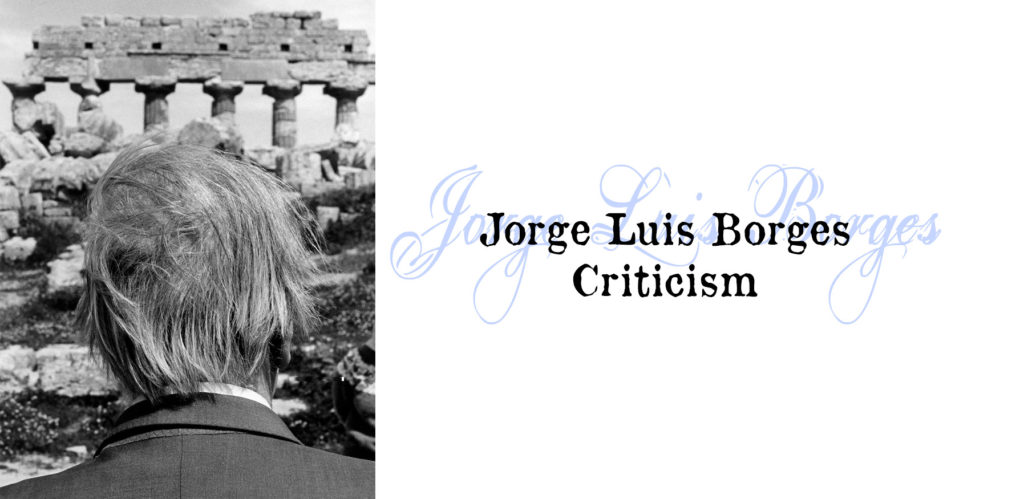Borges Criticism – Religious & Esoteric
- At August 29, 2019
- By Great Quail
- In Borges
 0
0
Do you want to see what human eyes have never seen? Look at the moon. Do you want to hear what ears have never heard? Listen to the bird’s cry. Do you want to touch what hands have never touched? Touch the earth. Verily I say that God is about to create the world.
—Jorge Luis Borges, “The Theologians”
Borges Criticism: Religious & Esoteric Criticism
This page collects English-language Borges criticism written from a religious, metaphysical, or esoteric perspective, including the Kabbalah, mysticism, gnosticism, eschatology, etc. (A complete list of Borges Criticism can be accessed at the bottom of the page.) The books are listed in chronological order of publication. Clicking the image of a book takes you directly to Amazon.com. Wherever possible, links to the Internet Archive are provided. These “online editions” may or may not match the exact edition of the corresponding book.
Each book contains a brief description and a summary of its contents. Some have also been reviewed. If any knowledgable visitor would like to submit comments for any of the “unreviewed” works, please contact the Garden!
Raid on the Articulate
Comic Eschatology in Jesus and Borges
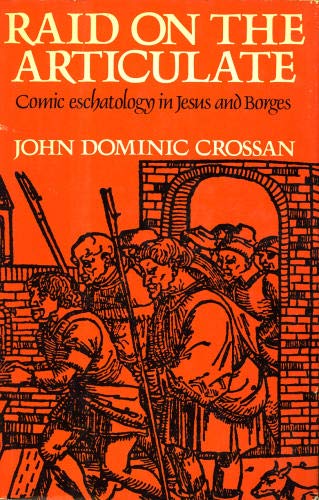
Raid on the Articulate: Comic Eschatology in Jesus and Borges
By John Dominic Crossan
Harper & Row, 1976
An Irish historian, religious scholar, and emeritus professor at DePaul University, John Dominic Crossan is renown for his work on explicating the historical Jesus. In 1976 Crossan published this account of Christian and apocalyptic themes in Borges.
Publisher’s Description: John Dominic Crossan’s In Parables demonstrated how Jesus’s parables demolished an idolatry of time. In this book, he shows how the parables likewise preclude an idolatry of language. In a new, creative synthesis, Raid on the Articulate juxtaposes the sayings and parables of Jesus with the works of modern Argentine writer Jorge Luis Borges to reveal fresh interpretations. Crossan locates both men as literary iconoclasts, parablers who can evoke for us the other side of silence. The gift they bring is “cosmic eschatology,” the ability to “stand on the brink of nonsense and absurdity and not be dizzy.” The discussion begins with “Comedy and Transcendence,” “a comedy too deep for laughter.” Language is seen most openly and acknowledged most freely as structured play, opening the narrow gate to transcendence. This precludes language being mistaken for the gate itself. This in turn raises the question of “Form and Parody.” As Crossan writes, “Why mock the craftsman skilled in silver and gold and not mock the artisan skilled in form and genre? What if the aniconic God became trapped in icons made of language?” In Jesus we find the most magisterial warning against graven words and encapsulation of God in case law, proverb, or beatitude. When Jesus says, “Whoever seeks to gain his life will lose it” he presents a paradox insoluble by faith in language. Borges performs a similar function in literature when he inserts footnotes referring to nonexistent books. Both are arguing against the idolatry of imprisoning reality in the words that point to it. “Parable and Paradox” makes the case for parable as paradox formed into story. It is in this context that Jesus and Borges must be understood. Analyzing many of Jesus’s parables, especially “The Good Samaritan,” and comparing them structurally to Borges’s work, Crossan sees them as single or double reversals of their audiences’ most profound expectations. It is these that lend them both their power and their paradox. Raid on the Articulate concludes with considerations of the plasticity of time in Jesus and Borges and what, finally, we can say about them as men from their “fragile and aphoristic art.” Emphasizing both biblical and literary materials, John Dominic Crossan achieves a deepened understanding of New Testament texts and forms, an understanding possible only when the unique literary aspect of Jesus’s sayings is acknowledged.
Jorge Luis Borges: Sources and Illuminations
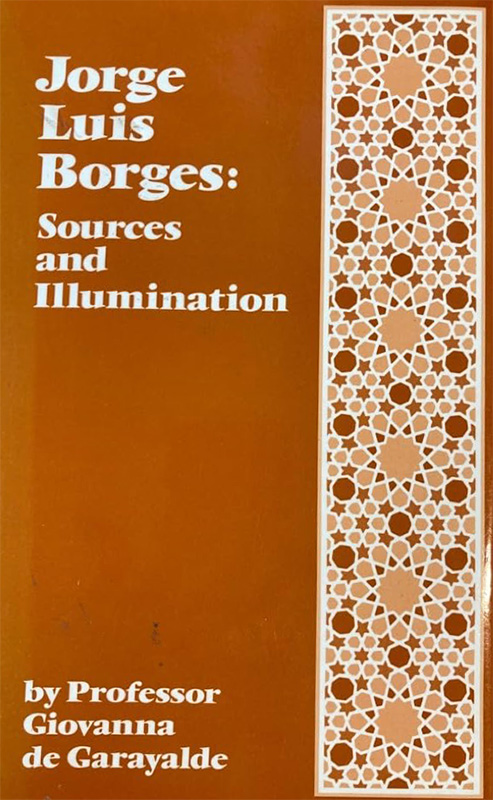
Jorge Luis Borges: Sources and Illuminations
By Giovanna de Garayalde
Octagon Press, 1978
Often cited in Borges scholarship, this early work of criticism examines Borges from the perspective of Islamic mysticism. The book’s author is somewhat mysterious, and often has the word “Professor” prefixed to her name. Sources and Illuminations was published by the now-defunct Octagon Press, a London publishing house founded in 1960 by Sufi teacher Idries Shah.
Publisher’s Description: A must for anyone interested in the work of the great Argentinian writer, Jorge Luis Borges. Professor Garayalde settles many of the puzzles and misinterpretations of his works in a very concise and convincing account both of the Sufis and their work—with which she became familiar long before she approached Borges’ own—and of the many parallels in ideas and in actual tales that are included in his work. This is an ideal introduction to Sufi thought for anyone who is searching for a greater understanding of life and him/herself through literature.
The Aleph Weaver
Biblical, Kabbalistic, and Judaic Elements in Borges
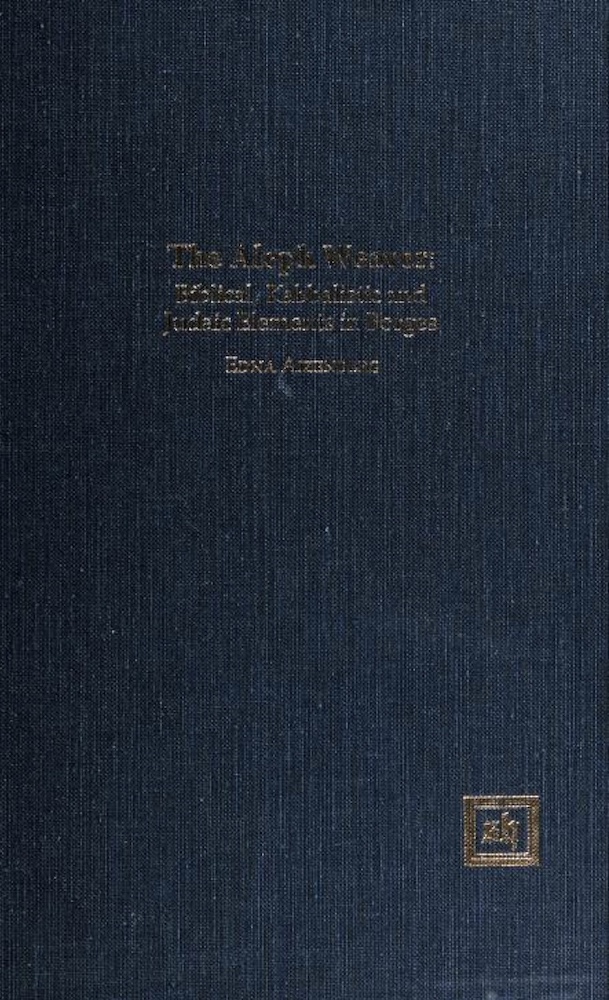 The Aleph Weaver: Biblical, Kabbalistic, and Judaic Elements in Borges By Edna Aizenberg Scripta Humanísta, 1984 Online at: Internet Archive |
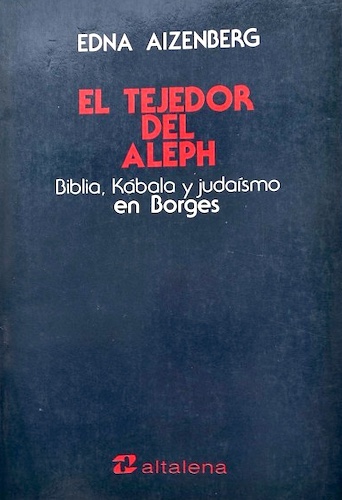 El tejedor del Aleph: biblia, kábala y judaísmo en Borges By Edna Aizenberg Madrid: Altalena, 1986 Online at: Internet Archive |
A professor at Marymount Manhattan College for over fifty years, Edna Aizenberg (1945–2018) was widely recognized a pioneer of Jewish studies in Latin American literature. The Aleph Weaver is the first of Aizenberg’s three books which focused on Borges. In 1986 it was translated into Spanish as El tejedor del Aleph. The translation won the Fernando Jeno Award, a Mexican prize for the best literature and poetry in Spanish, Hebrew, and Yiddish.
Table of Contents:
Introduction
Part I
1. Bilingualism and Biblicism
2. Jewish Friends, German Texts
3. Ultraism and Judaism
4. The Jewry Is on Talcahuano and Libertad
5. Nazism and Judaism
6. Monsterfest
7. The Oldest of Nations Is Also the Youngest
Part II
Introduction
1. The Bible Is the Point of Departure for Everything
A. The Holy Spirit
B. The Book of Job
2. A Vindication of the Kabbalah
A. The Corpus Symbolicum
B. The Absolute Book
C. Pseudepigraphy, Commentary and Innovation through Tradition
3. The Diverse Intonation of Some Jewish Metaphors
Introduction
A. It’s the Story of Cain/Who Continues Killing Abel
B. A Man Who Is the Book, … the Jew
C. The Jewish Gauchos
Index
Reviews: Ilan Stavans’ review of The Aleph Weaver was published in Prooftexts, Vol. 7, No. 1 (January 1987): pp. 96–105, [JSTOR paywall]. A lengthy examination of the book and its subject, Stavans claims “there has never been so complete and accurate a book on the Jewish subject in Borges as The Aleph Weaver.” Solomon Lipp’s review appeared in Revista Canadiense de Estudios Hispánicos, Vol. 12, No. 3 (Primavera 1988): pp. 490–493, [JSTOR paywall.] The following excerpts from Lipp’s review offer a good summary of Aizenberg’s book:
Professor Edna Aizenberg’s volume on Jorge Luis Borges is a stimulating addition to the field of Borges studies. It is bound to provoke controversy because of the basic thesis proposed, namely, that Borges’ fascination with lo hebreo, his interest in Jewish culture, is intimately connected with his Latin American identity. Aizenberg maintains that the Hebraic element is a fundamental ingredient in Borges’ conception of his literary production. The Jew as intellect is an important metaphor in Borges; in fact, this primary con figuration of the Jew, reinforced in his mind by Jewish contributions to European civilization, has nurtured his attraction to Judaism: Hebrew Scriptures, Spinoza’s speculations, Heine’s writings, German Expressionist poetry—all belong to the orbit of Judaism and contribute to Borges’ fondness for lo hebreo—not a very common manifestation in Spanish American literature. For Borges the quality of innovativeness is an intellectual posture considered to be Judaic.
Given this basic premise, Professor Aizenberg has undertaken to examine personal, historical and cultural circumstances which have contributed to Borges’ approach to lo hebreo. To this end she examines some of his less-known texts and discusses his myths and techniques related to the subject. She also enriches her study with continual references to the works of other Borges scholars, as well as authorities on Jewish mysticism to whom Borges feels particularly attracted. Finally, Aizenberg’s work is dotted with periodic quotations, extracted from her recorded interviews with Borges.
[…]
Borges is cast in the role of the “Aleph Weaver” as the title of the book indicates. Professor Aizenberg, herself, is no mean weaver as she brings together in skilful fashion the various Judaic strands of Borges’ inspired creativity which produce a rich and colorful tapestry—one which the reader is certain to enjoy.
Borges and the Kabbalah
And Other Essays on His Fiction and Poetry
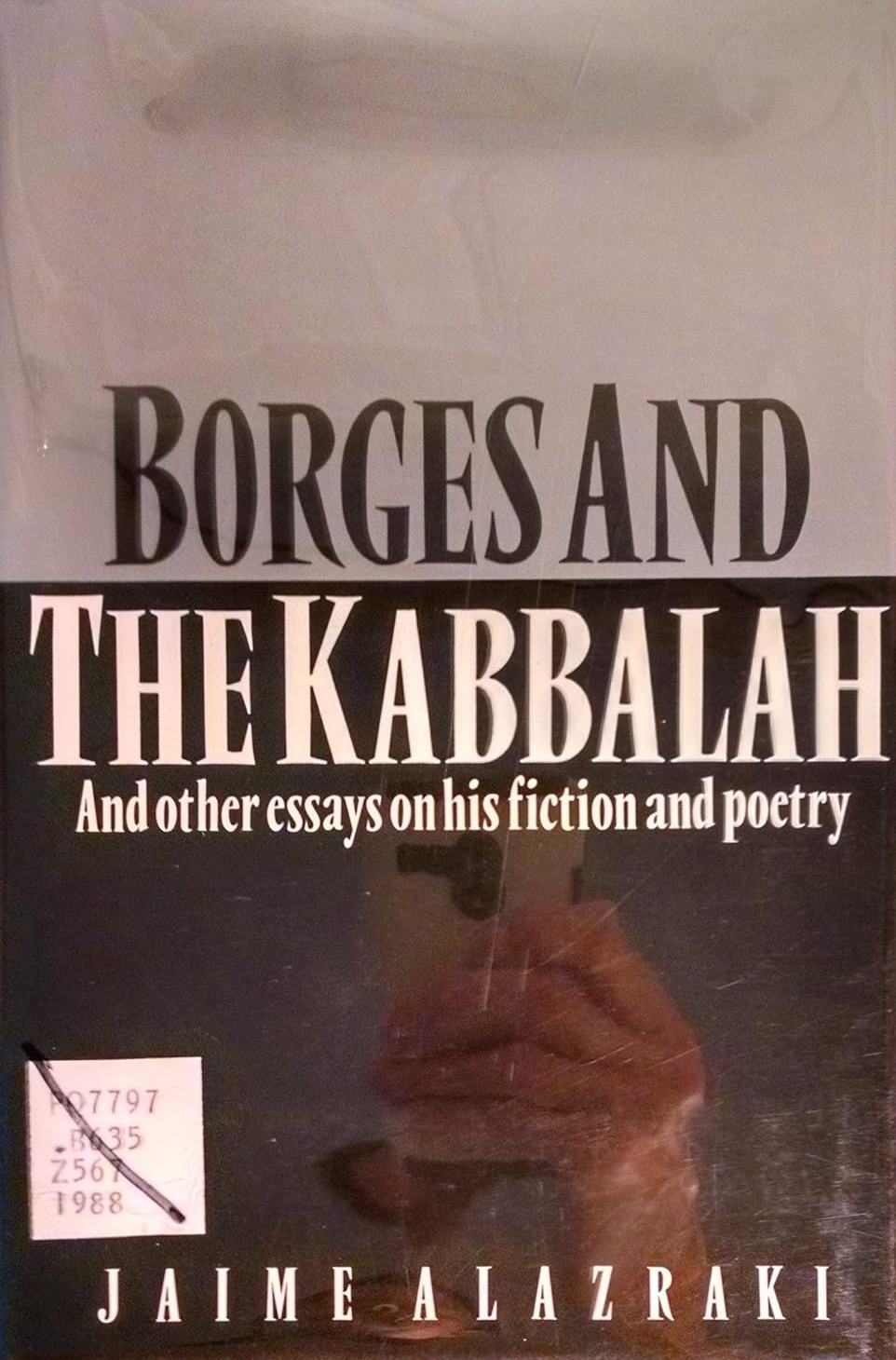
Borges and the Kabbalah: And Other Essays on His Fiction and Poetry
By Jaime Alazraki
Cambridge University Press, 1988
Online at: Internet Archive
Born in Argentina, Jaime Alazraki (1934–2014) was a literary critic who received his Ph.D. in philosophy from Columbia University, where he later served as the chair the department of Spanish and Portuguese. A celebrated Borges scholar, Alazraki was fascinated by Jewish mysticism, and many of his early papers examined Borges’ use of the Kabbalah.
Publisher’s Description: The Argentinian Jorge Luis Borges was one of the most influential figures to emerge from the great blossoming of South American literature in the twentieth century. As a scholar, poet, critic and writer of fiction he was widely read in English translation. This volume brings together a collection of essays on Borges by leading scholar Jaime Alazraki. Together the essays constitute an introduction to important aspects of Borges’ oeuvre, including the influence of the Kabbalah, structure and style in the fiction, Borges’ poetry, and Borges’ impact on Latin American literature. Students and scholars of contemporary literature will find here in one volume the best of Professor Alazraki’s short pieces on this great writer.
Table of Contents:
I. Borges and the Kabbalah
1. Introduction
2. Borges and the Kabbalah
3. Kabbalistic Traits in Borges’ Narratives
4 Appendix to Part I: “The Kabbalah,” by Jorge Luis Borges
II. Fiction
5. Structure as Meaning in “The South”
6. Borges, or Style as an Invisible Worker
7. The Making of a Style: A Universal History of Infamy
III. Poetry
8. Outside and Inside the Mirror in Borges’ Poetry
9. Enumerations as Evocations: On the Use of a Device in Borges’ Late Poetry
10. Language as a Musical Organism: Borges’ Later Poetry
IV. Essays and Other Questions
11 Oxymoronic Structure in Borges’ Essays
12 Borges and the New Latin American Novel
Reviews: John King’s review of Borges and the Kabbalah was published in the Bulletin of Hispanic Studies, Vol. 64, Issue 2 (April 1987): pg. 182, [ProQuest paywall].
Borges’ Esoteric Library
Metaphysics to Metafiction
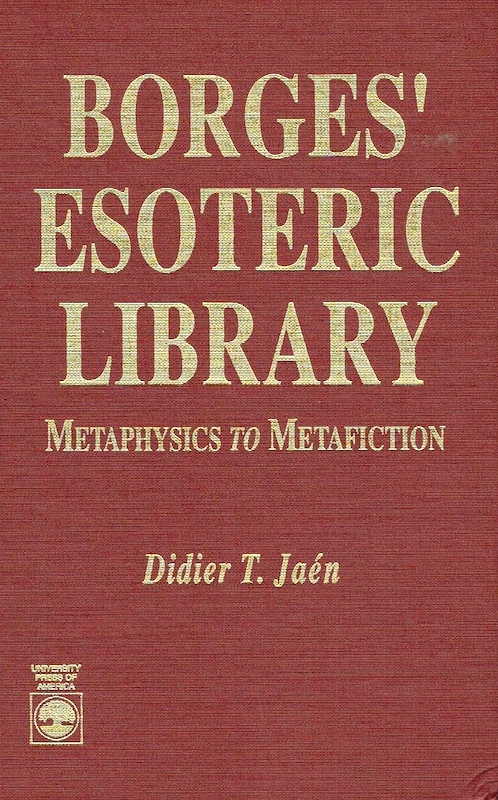
Borges’ Esoteric Library: Metaphysics to Metafiction
By Didier T. Jaén
University Press of America, 1992
Born in Panama, Didier Tisdel Jaén (1930–2011) was a Professor Emeritus of Spanish and Classics at the University of California. According to the publisher, Jaén’s book is an examination of “Borges’ use of allusion to esoteric and metaphysical doctrines,” which is presented as foundational to his “renovation of fiction toward metafiction.”
Table of Contents:
- Borges and the Esoteric Tradition
- The Esoteric
- The Fantastic, and Borges’ Metafiction
- Borges’ Art: Metaphysics as Metafiction
- The Loss of the Self
- The Loss of Reality
- The Loss of Time
- The Loss of Words
- The Loss of Salvation
- “Tlön, Uqbar, Orbis Tertius” and The Esoteric Tradition
- Conclusion
Sadly, Jaén’s book is out of print, and used copies are somewhat rare and expensive.
Borges and the Esoteric
Borges and the Esoteric
Edited by Robert Lima
Pittsburgh: Duquesne University, 1993
Robert Lima is a Cuban-American playwright, literary critic, and translator, Professor Emeritus of Spanish and Comparative Literatures at Pennsylvania State University. (He also holds a Spanish knighthood!) Borges and the Esoteric was printed as a special issue of Crítica Hispánica—Vol. XV, No. 2, Fall 1993. The book is 128 pages long and contains the following academic papers and essays:
- Introduction by Robert Lima: “Borges and the Esoteric”
- Edna Aizenberg, “Feminism and Kabbalism: Borges’s ‘Emma Zunz’”
- Jaime Alazraki, “El componente sufí de ‘El acercamiento a Almotásim’”
- Timothy Ambrose, “Borges and the Vedic Tradition: Consciousness as the Source of the World”
- Willis Barnstone, “Memoir about a Metaphysical and Mystical Poet”
- Carlos Cortínez, “About Face in Borges”
- Julia Cuervo Hewitt, “El círculo del cuadrado en el cuadrado del círculo: ‘La muerte y la brújula’ de Borges”
- John T. Irwin, “Double You, Double V: Borges and Poe in the Labyrinth”
- Robert Lima, “Borges, the Man with the Occult Eye”
- Naomi Lindstrom, “Borges and Jewish Mysticism: Paradoxical Interrelations”
- Paul West, “A Borgesian Beast”
Reviews: Shortly after publication, Nancy Brown interviewed Robert Lima at Penn State for a profile on Borges. She remarks about the book:
It is these shunting devices that Lima focuses on in the Crítica Hispánica volume, titled Borges and the Esoteric. Lima’s own contribution takes on numerology, another brings together feminism and ancient Jewish Kabbalism, a third Sufism.
Contributor Timothy Ambrose, of Maharishi International University, finds parallels between the Vedic tradition of ancient India and Borges’ “Las escritura de Dios.” In the story, a pre-Columbian magician, imprisoned by the Spaniards, learns to read the markings on a tiger. “The deciphering of that magic writing,” writes Ambrose, “bestows upon him a knowledge of infinity, a knowledge which allows him to accomplish anything. Nonetheless, he chooses to remain imprisoned lying in the darkness.” Like the Vedic seers, he has “taken his individual mind to the level of cosmic mind . . . and has seen for himself that absolute silence is the creative energy and intelligence of eternal Being.” At the end, the reader is left to wonder if the events of the story happened only in the narrator’s mind, “a mind ultimately uninvolved with the play and display of its own creation.”
Penn State professor Julia Cuervo Hewitt, whose contribution is in Spanish, discusses the intertwining of alchemy and Kabbalism in another story, “La muerte y la brujula.” “The main character and the reader,” she writes in an English abstract, “are led to believe that the solution to the riddles of the text, as well as to the murder with which the story begins, can be found in the Kabbalah. The structure of the text, however, follows a different tradition. . . . In typical Borgesian style, the search for truth in this short story is always a futile effort. At the end, man always finds himself lost and trapped in the labyrinths created by his own imagination.”
Borges and Philosophy
Self, Time, and Metaphysics
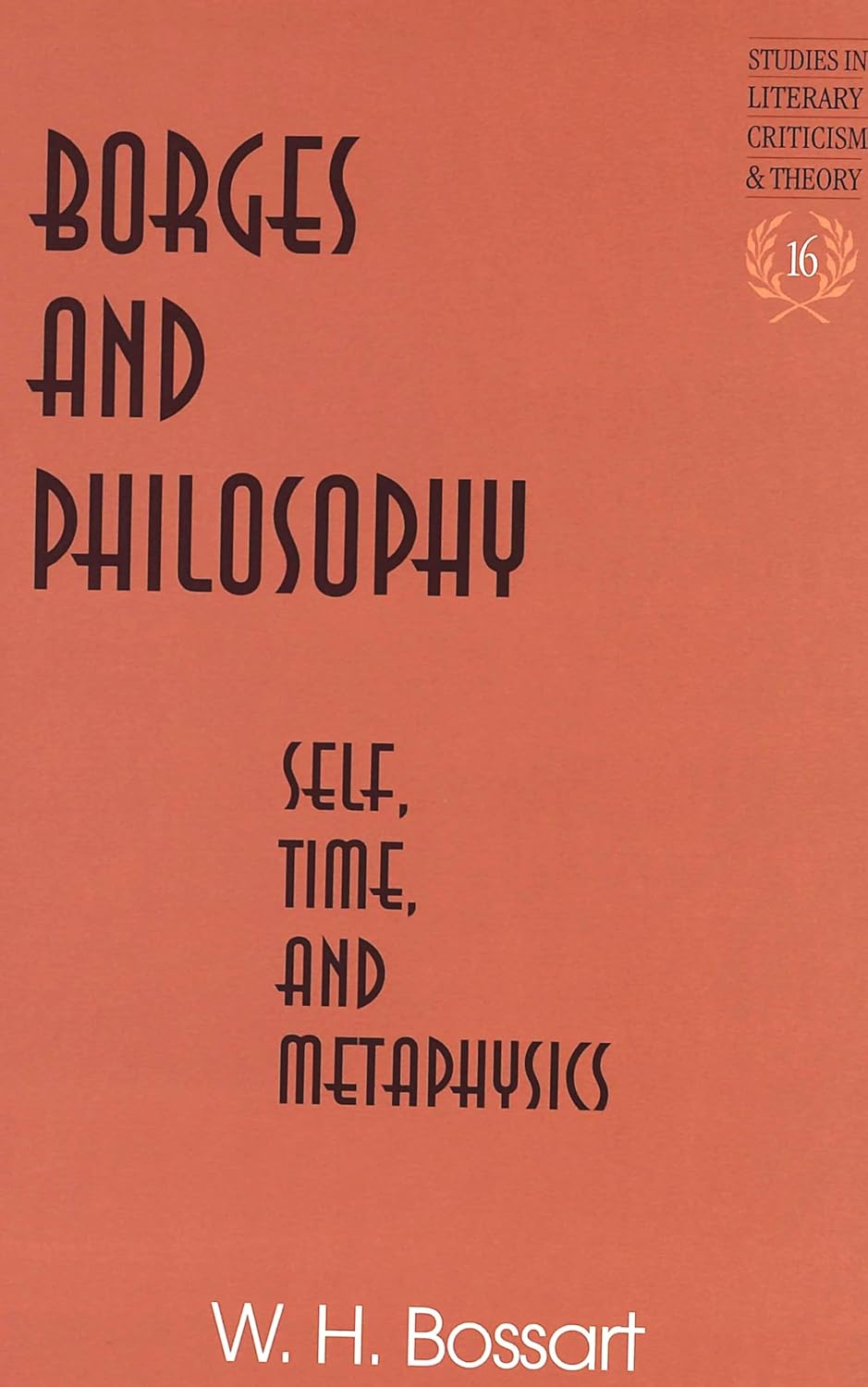
Borges and Philosophy: Self, Time, and Metaphysics
By W.H. Bossart
Peter Lang, 2003
William H. Bossart is Professor Emeritus of Philosophy at the University of California, Davis. His areas of study include “metaphysics, aesthetics, German philosophy from Kant to Heidegger, and contemporary French thought.” Borges and Philosophy is Book 16 in Peter Lang’s “Studies in Literary Criticism and Theory” series.
Publisher’s Description: Jorge Luis Borges is acknowledged as one of the great Spanish writers of the twentieth century. On the broader literary scene, he is recognized as a modern master. His fascination with philosophy—especially metaphysics—sets him apart from his contemporaries. Borges appreciated and formulated rigorous philosophical arguments, but also possessed the unique ability to present the most abstract ideas imaginatively in metaphors and symbols. Borges wandered among the great masters seeking a firm purchase that he could not find, and therefore expressed a nostalgia for metaphysics as he lost himself in his labyrinths. Borges and Philosophy traces Borges’ philosophical concerns in his tales, essays, and poems and argues that despite his apparent skepticism in philosophical matters, a careful reading of Borges’ texts reveals a coherent philosophical path that underlies his work.
The Quest for God in the Work of Borges

The Quest for God in the Work of Borges
By Annette U. Flynn
Continuum, 2009
Annette Flynn is Lecturer in Spanish and Portuguese at University College Dublin.
Publisher’s Description: This book argues that the quest for God, though largely unheeded by the critical canon, was a major and enduring preoccupation for Borges. This is shown through careful analysis both of his essays, with their emphasis on his philosophical-theological explorations, and of the narrative articulations which are his stories. It is in the poetry of his middle and closing years, however, that Borges’ search is most manifest, as it is no longer obscured. Spanning different periods of his life, and different literary genres, Borges’ work attests to a maturing and evolving quest. The book reveals Borges’ engagement as an active and evolving process and its chronological structure allows the reader to trace his thought over time. Flynn shows that the spiritual component in Borges’ writing drives key texts from the 1920s to the 1980s. Offering an interpretation that unlocks a fuller significance of his work, she shows how Borges’ reflections on time and identity are symptomatic of a deeper, spiritual searching which can only be answered by a Divine Absolute.
Table of Contents:
Preface
2. From Essay to Ficción
3. The Long Quest
Conclusion
Appendix
Bibliography
Index
Reviews: Melvin S. Arrington’s review of The Quest for God in the Work of Borges was published in The Latin Americanist, Vol. 54, No. 3, (Sep. 2010): pp. 100–102, [Project MUSE paywall]. Sarah Roger’s review appeared in Religion & Literature, Vol. 46, No. 2/3 (Summer-Autumn 2014): pp. 201–203, [JSTOR paywall]. She cautions that Flynn “is limited by her focus, which is primarily Christian,” but finds the book a worthwhile read:
Flynn investigates the presence of God in Borges’s work, focusing on his burgeoning interest in Christianity. While many scholars believe Borges was a sceptic, an agnostic, or even an atheist, Flynn proposes a compelling alternative. She argues that Borges’s writing reveals his “attempt to relate to himself the full meaning of Christ’s sacrifice;” as proof, she demonstrates how Christian themes feature in his essays from the 1920s to the 1950s, in his short stories from the 1930s and 1940s, and in his poetry from the 1950s onward. The aim of Flynn’s project is to establish whether Borges’s writing demonstrates a personal “lived faith experience” that allowed him to “overcome the doubts and uncertainties which his intellectual probing uncovered.”
Borges, the Jew
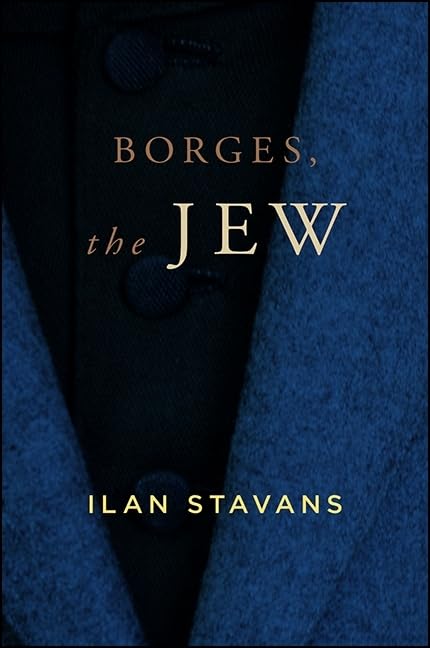
Borges, the Jew
By Ilan Stavans
State University of New York Press, 2016
Born in Mexico as Ilán Stavchansky, Ilan Stavans is the Lewis-Sebring Professor of Humanities, Latin American and Latino Culture at Amherst College. A noted linguist, essayist, and translator, Stavans is best known for translating English and Spanish classics into Spanglish—a project that’s attracted a certain amount of controversy. He’s also the co-founder of Restless Books, and has been working on a two-part biography of Gabriel García Márquez.
Publisher’s Description: Explores Borges’s infatuation with Jewish history and culture. In this volume, award-winning cultural critic and controversial public intellectual llan Stavans focuses his attention on Jorge Luis Borges’s fascination with Jewish culture. Despite not being Jewish himself, Borges wrote essays, poems, and stories dealing with various aspects of Jewish history and culture-from the Holocaust to Kabbalah and from Franz Kafka to the creation of the State of Israel. In periods when anti-Semitism in Argentina was on the rise, Borges was clear in his refutation of such xenophobia, and when Jewish writers were hardly available in Spanish, he was among the first to translate them. Throughout Stavans’s discussion of these topics he weaves in personal anecdotes on reading Borges for the first time, hearing him read in Mexico, and looking for him in Buenos Aires. No fan of Borges’s classic oeuvre will ever see his legacy in the same way after reading this book.
Table of Contents:
Preface: Outsider
1. Yo, Judío
2. A Short Catalog of Jewish Symbols
3. “Deutches Requiem”
4. Beyond Translation
5. On the Language of Ghosts
6. Coda: Borges y Yo
Additional Information
In 1987 Ilan Stavans reviewed Edna Aizenberg’s The Aleph Weaver in Prooftexts, Vol. 7, No. 1 (January 1987): pp. 96–105, [JSTOR paywall]. More than a simple review, Stavans discusses the subject of Borges and Judaism at length. Stavans published an article entitled, “Borges, the Jew” in the Summer 2012 issue of the Jewish Review of Books. An excerpt of Borges, the Jew appeared as “How Borges Taught Me to Embrace My Jewish Heritage” in Literary Hub, 2 September 2016.
Borges, Buddhism, and World Literature
A Morphology of Renunciation Tales
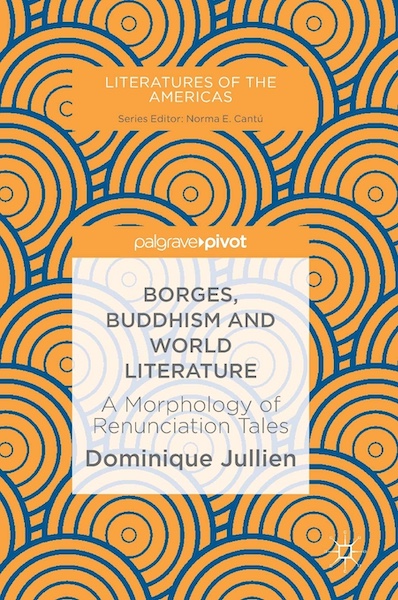
Borges, Buddhism, and World Literature: A Morphology of Renunciation Tales
By Dominique Jullien
Palgrave Macmillan, 2019
Online at: Springer Link [Excerpts]
Dominique Jullien is Professor of Comparative Literature and French Studies at the University of California, Santa Barbara. Her areas of interest include “nineteenth- and twentieth-century literature and culture, Proust studies, Borges studies, intertextuality and rewriting, travel narratives, cognitive approaches to literature, and East-West relations.”
Publisher’s Description: This book follows the renunciation story in Borges and beyond, arguing for its centrality as a Borgesian compositional trope and as a Borgesian prism for reading a global constellation of texts. The renunciation story at the heart of Buddhism, that of a king who leaves his palace to become an ascetic, fascinated Borges because of its cross-cultural adaptability and metamorphic nature, and because it resonated so powerfully across philosophy, politics and aesthetics. From the story and its many variants, Borges’s essays formulated a “morphological” conception of literature (borrowing the idea from Goethe), whereby a potentially infinite number of stories were generated by transformation of a finite number of “archetypes.” The king-and-ascetic encounter also tells a powerful political story, setting up a confrontation between power and authority; Borges’s own political predicament is explored against the rich background of truth-telling renouncers. In its poetic variant, the renunciation archetype morphs into stories about art and artists, with renunciation a key requirement of the creative process: the discussion weaves in and out of Borges to highlight modern writers’ debt to asceticism. Ultimately, the enigmatic appeal of the renunciation story aligns it with the open-endedness of modern parables.
Table of Contents:
Part I. A Borgesian Morphology: Renunciation, Morphology, and World Literature
1. A Borgesian Morphology
1.1. “The Universe Is Our Birthright”: Buddhism and the Cosmopolitan Ideal
1.2. Borges’s Essays on Buddhism, Narrative Circulation, and Morphology
1.3. Borgesian Weltliteratur
1.4. A Morphological Conception of Literary Inventio
2. “Ethics for Immortals”: Buddhism, Impersonality, and the Novel
3. Renunciation, Politics, Blindness
Part II. A Lesson for the King: Renunciation and Politics
1. The Appeal of Paradox
2. The King-and-Ascetic Dialogue and the Mirror for Princes
3. The King-in-Disguise Paradigm
4. Burton’s Hermits: Reforming Shahryar
5. Asiatic Parrhesia
6. The Otherworldly Variant: Radical Renunciation and the Ascetic Imperative
7. Victorian Renouncers
Part III. From Ascetic to Poet: Poetic Renunciation
1. The Buddha and the Maker
2. Borgesian Poet Stories, Artist Lives, and Künstlerroman
3. Poets-as-Ascetics in World Literature
4. J. L. Borges, Author of The Temptation of Saint Anthony
4.1. Libraries on Fire: Flaubert, Borges, Foucault and the Triangle of Interpretation
5. Fin-de-siècle Cynics: Marcel Schwob’s Crates, Arch-Renouncer
6. Renunciation as Vanishing Act: Marguerite Yourcenar’s Wang-Fo
7. Poetry as Renunciation: Yi Mun-yol’s The Poet
8. The Mystery of Renunciation
8.1. Charms O’erthrown: Prospero’s Shadow
Part IV. Modernity’s Enigmatic Parables of Renunciation
1. Borgesian Parables and the Enigmatic Mode
2. Parables and Paradoxes: Kafka, Borges and the Modern Debate on Parables
3. Kafka’s Ironic Renunciation Parable: “A Hunger Artist”
4. Borges’s Renunciation Parables: Epiphany, Renounced
4.1. Understanding the Writing on the Tiger
4.2. “No Way Out of the Chaos”
4.3. Caged Tigers: A Borgesian Theodicy
5. Elusive Meaning: Karen Blixen’s “A Consolatory Tale”
Conclusion: Renunciation Stories and Wandering Kings
Works Cited
Index
Reviews: Manuel Azuaje-Alamo’s review of Borges, Buddhism, and World Literature was published in Comparative Literature Studies, Vol. 58, No. 3 (2021): pp. 657–660, [Project MUSE paywall]. Liesbeth François’s review appeared in Romanic Review Vol. 114, No. 3 (2023): pp. 640–643, [Duke University paywall]. Both reviewers recommend the book, both calling it “fascinating.” A few excerpts from Azuaje-Alamo’s review may help make sense of Jullien’s sprawling table of contents:
In her fascinating new study, Borges, Buddhism and World Literature: A Morphology of Renunciation Tales, Dominique Jullien…convincingly makes the case for yet another role that Borges is perfectly fit to play within World Literature Studies: that of continuator and further disseminator of the Buddhist Renunciation Tale as a morphological archetype in fictional literature. Jullien considers the aesthetic and political implications that the renunciation tale has on his work, first by reading Borges’s own interest in the archetype against the background of the rise of Perón’s left-wing populism in Argentina during the 1950s—the decade that Jullien sees as Borges’s Buddhist decade—and then by proceeding to tease out the implications that the renunciation tale has on Borges’s own philosophy of literature as seen in multiple examples of his vast oeuvre.
Thus, Jullien’s book reframes Borges as a significant node in the propagation and creation of a literary intertextuality that has its origin in the story of the historical/fictional Buddha—a story Borges detailed in the cowritten book What Is Buddhism? (1976). Jullien argues that the renunciation archetype extends down history and is present in the renunciation parables found in the work of modern and contemporary authors from around the globe.
The book’s introduction provides one of the most concise and yet rigorous compilations of past scholarship on Borges’s relationship with Buddhism. As multiple scholars have argued, what for Borges started as an early interest in East Asian literature and philosophy developed during the 1950s into an ultimately lifelong fascination with Buddhism and Zen aesthetics that became increasingly prominent in his texts written during the 1970s and 1980s. Jullien’s objective in the chapter is not to trace the origins, acuity, or fidelity of Borges’s knowledge regarding Buddhism and its many schools. Rather, as is the point of the whole book, the goal is to shed light on the “ways in which the Buddha triangle, pulling together Buddhism, Schopenhauer, and Idealism in a shared negation of the individual self, yielded a serviceable pattern to decades of Borgesian stories, poems, and essays.”
Borges Criticism
Main Page — Return to the Borges Criticism main page and index.
General Criticism 1 — General literary criticism and commentary written during Borges’ life, 1957–1986.
General Criticism 2 — General literary criticism and commentary written from 1987 to 1999.
General Criticism 3 — General literary criticism and commentary written from 2000 to the present.
Poetics — Criticism written about Borges’ poetry and poetics.
Comparative Criticism — Borges criticism that compares Borges with other writers or locates Borges’ work within a broader literary context such as genre fiction or Latin American Literature.
Political & Theoretical Criticism — Borges criticism with a strong political, theoretical, or philosophical component: Marxist critique, postmodernism, postcolonial studies, gender studies, queer theory, disability studies, etc.
Scientific Criticism — Borges criticism within the disciplines of science, mathematics, and technology.
Author: Allen B. Ruch
Last Modified: 22 August 2024
Main Borges Page: The Garden of Forking Paths
Contact: quail(at)shipwrecklibrary(dot)com

